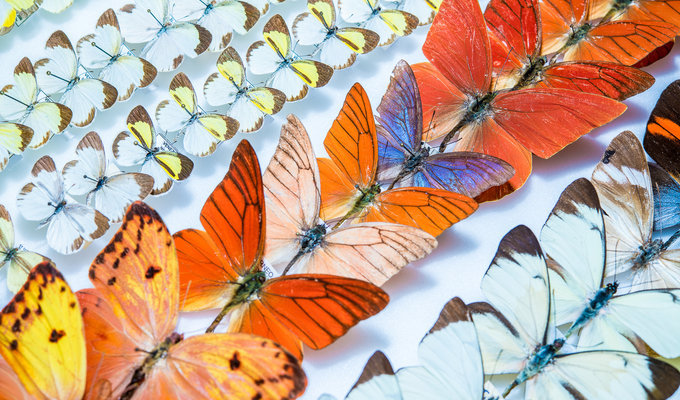The origins of the entomological sub-collection of the National Museum are very old. Some specimens come from the first half of the 19th century, and the oldest collection specimen, the common green birdwing (Ornithoptera priamus) from Indonesia, allegedly comes from 1787 (see photo below). Valuable material for the collections of the National Museum was gathered abroad in cooperation with our compatriots. The National Museum holds the entomological collections of famous Czech travellers, for example Jan Vilém Helfer’s collection, gathered in Burma, and Emil Holub’s, from South Africa.
Some entomological collections of the National Museum are built systematically from bequeathals, purchased private collections and in-the-field collecting by the National Museum's staff, which is not limited only to the Czech Republic. In-the-field collecting abroad was traditionally focused on the Balkan Peninsula, but in the post-war years the entomological department organized several large expeditions: to Turkey in 1947 and to Iran in 1970, 1973 and 1977. Thanks to these expeditions, the National Museum nowadays holds possibly the largest collection of Iranian insects in the world.
Currently, the entomological department of the National Museum holds the largest collection of insects in the Czech Republic, numbering almost five million specimens from around the world. Due to the traditional interests of collectors, beetles and butterflies are prevalent. However, in recent years increased attention has been paid to the expansion of the collections of other insect orders. Since with long-term exposure to light the colour of the insects fades and the specimens thus lose their value, most of the collection is permanently stored in depositories and is exhibited only occasionally, in temporary exhibitions. These collections serve primarily as comparison and documentary material for the scientific study of insects, which is conducted by external experts and university students in addition to museum staff. Each year, 250 domestic and foreign researchers visit the entomological department for these purposes.
Related collections
- Enthomological collection – Diptera The Diptera sub-collection contains over 250,000 dried specimens. Further, it contain a great number of alcohol-preserved specimens and also 30,000 microscopic specimens.
- Entomology collection – Polyneoptera This collection includes these orders: stick insects (Phasmatodea), mantises (Mantodea), cockroaches and termites (Blattodea and Isoptera), angel insects (Zoraptera), earwigs (Dermaptera) and grasshoppers, locusts and crickets (Orthoptera).
- Entomological collection – Hemiptera The collection of Hemiptera insects includes approximately 410,000 specimens of true bugs (Heteroptera), Auchenorrhyncha, psyllids (Psyllomorpha), scale insects (Coccoidea) and whiteflies (Aleyrodoidea) from around the world, primarily from the Palearctic.
- Entomological collection – Lepidoptera (butterflies) The collection of butterflies is stored in three halls with an area of 240 m2. The collection material is held in approximately 7,000 collection boxes, mostly 40x50x6 cm size, and their number nears one million.
- Entomological collection – small orders The fonds includes representatives of small insect orders, particularly dragonflies and damselflies, stoneflies, net-winged insects, caddisflies and others. In total, the collection contains over 110 thousand specimens.
- Entomological collection – Hymenoptera The collection of Hymenoptera contains about 550,000 dry specimens and an unknown number of fluid (ethanol)-preserved items, both identified and unidentified specimens from around the world.
- Entomological collection – Coleoptera (beetles) The collection of beetles is the largest of the insect collections in the National Museum. It contains approximately 5 million specimens, mostly dry, in entomology boxes.

